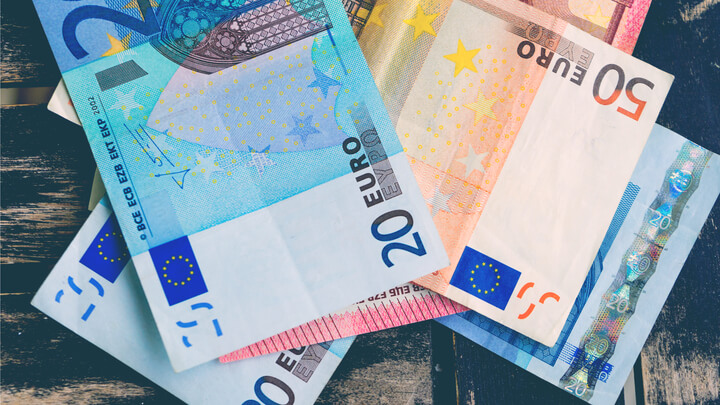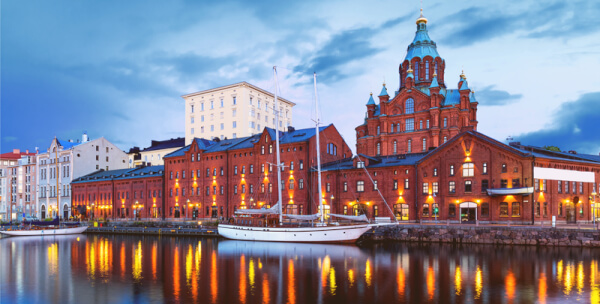ATMs in Finland: Credit cards and fees
In recent years, cash has actually become increasingly rare in Finland as more and more shoppers switch to plastic. That’s good news if you plan to use a...

In Finland, travel and tourism means big business: in 2013 alone well over 100,000 jobs were created by tourism. Recently, the country saw over four and a half million overseas visitors flood into the country. The figure is expected to continue to rise as more and more tourists flock to explore Finland’s natural beauty.
Fancy visiting? There’s plenty of reasons why you should. The country is famous for its gorgeous lakes, dramatic scenery and thriving winter sports scene. But you’ll need plenty of money to hand in this notoriously expensive country. To make sure you don’t spend more than you need to while converting your cash to euros, we’ve put together this handy guide to help you make sense of ATMs, banking and currency exchange in Finland.
The Finnish Markka was replaced in 2002 with the euro, making Finland the only Nordic country to join the European single currency. The Markka is now out of circulation and the Euro is the only form of legal tender in Finland.
The Euro is divided into 100 cents and is available in both coins and banknotes. Notes start at €5 and go up to €500, with €10, €20, €50, €100 and €200 bills in between. Coins are available in 1c, 2c, 5c, 10c, 20c and 50c, €1 and €2. Be aware that 1 cent and 2 cent coins are no longer in general circulation in Finland, but can still be used.
Finnish Euro coins have their own decoration, featuring a cloudberry – a gold coloured plant native to the country. However, don’t get worried if you find coins with non-Finnish designs. Each EU country has its own coins, but they can be used in any of the EU countries.
Finland – like much of Northern Europe – is considered relatively expensive to visit. The capital city of Helsinki is known for its high prices, so make sure to budget accordingly when planning your trip. Alcohol is heavily taxed, so you’d be wise to keep bar crawls to a minimum. Luckily, Finns love spending time outside in nature, so making the most of the country’s spectacular scenery shouldn’t break the bank.
Because Finland uses euros, exchanging money in the country should be fairly easy. This means it’s worth waiting until you reach your destination until you exchange to get a more favourable rate. And try not to exchange too much money into euros – they’re expensive to change back into your home currency if you have money leftover at the end of your trip.
While you’ll find plenty of places to exchange cash in Finland, it’s worth shopping around to ensure you don’t get stung with extra fees or unfavourable exchange rates. Changing currency at the airport, for example, is never a good idea. It may be convenient at the time, but you’ll pay heavily for the privilege, as airport vendors are unlikely to give you the best rate. Beware any ‘Zero Commission’ claims, too – the fees that exchange services charge are usually wrapped into the cost of the conversion. For the same reason, hotels are usually not a good place to exchange currency either.
Making sure that you know themid market rate before you get to Finland is vital. The mid-market rate is the only genuine exchange rate as it doesn’t include any commission or fees. It’s the same one you’ll find on Google and the same ones that big banks use to trade money on the global market. Use it as a benchmark comparison for any currency you buy to make sure that any charges are fair and you aren’t being ripped off.
Traveller’s cheques are usually only accepted and exchanged by banks in Finland, not vendors. Make sure you have back up cash to avoid any embarrassing scenarios in restaurants or at tourist attractions. Throughout Europe, Travellers Cheques are used less and less, so it’s more convenient to use either cash or credit and debit cards.
If you’re lucky enough to find any vendors that do accept Traveller’s Cheques, you’ll probably find that the exchange rate offered isn’t great, so you’ll end up spending more for less. Be on the safe side – leave your Traveller’s Cheques at home.
Visa, Mastercard, American Express and Diner’s Club Cards are all widely accepted in Finland. Using credit and debit cards is the most popular way of paying for goods and services in the country, so it’s a good alternative to cash or cheque. However, call your bank before you travel to make sure find out about any charges that could be incurred when paying by card.
Also, be prepared to show a photo ID when purchasing goods by card - this is a very common practice all across the country.
Finnish banks don’t have their own ATM machines. OTTO is the country’s interbank network, connecting almost every bank in the region. While you’ll be able to select an English language option at OTTO machines, there are some big differences between these and ATMs you’ll find at home. For example, OTTOs have 2 card slots - a blue one for chip and pin cards, and a yellow insert for cards that have a magnetic stripe. Since 2017, you are also able to use Nosto ATM machines which currently have around 500 locations around the country.
Withdrawing from an OTTO or Nosto with a credit card is usually the cheapest and simplest way of withdrawing cash in Finland. However, machines or service providers may offer you an option of being charged in your home currency (this is called dynamic currency conversion). Though it may feel more comfortable, it’s not a good idea. Instead, make sure that you always choose to be charged in the local currency (€) not your home currency. Being charged in the local currency means that your bank or credit card provider will set the exchange rate for your withdrawal, which will often be much more favourable than the one the ATM would give you.
Take some form of ID with you when going to a bank in Finland. Whether you’re opening an account or trying to cash a Traveller’s Cheque, photo ID is a must – a passport is the best option. The country is well-served with lots of commercial banking options. Below are some of the most common:
| Bank name | Website |
|---|---|
| Nordea Bank Finland | www.nordea.fi |
| Osuuspankki | www.op.fi |
| S-pankki | www.s-pankki.fi |
| Handelsbanken | www.handelsbanken.fi |
| Aktia | www.aktia.fi |
Alternatively, these foreign banks also have branches in Finland:
| Bank name | Website |
|---|---|
| Deutsche Bank | www.db.com |
| Carnegie Investment Bank | www.carnegie.se |
| Danske Bank | www.danskebank.fi |
| Citibank | www.citibank.com |
| Forex Bank | www.forex.se |
However, if you need to send money to Finland or back to your home country, you might consider using Wise. If you or someone you know has a bank account in Finland, you can transfer money between accounts via a local bank transfer, which cuts out international fees. Not only that, but Wise uses the real mid-market exchange rate. That means no hidden fees, so the price you see is the price you’ll get.
*Please see terms of use and product availability for your region or visit Wise fees and pricing for the most up to date pricing and fee information.
This publication is provided for general information purposes and does not constitute legal, tax or other professional advice from Wise Payments Limited or its subsidiaries and its affiliates, and it is not intended as a substitute for obtaining advice from a financial advisor or any other professional.
We make no representations, warranties or guarantees, whether expressed or implied, that the content in the publication is accurate, complete or up to date.

In recent years, cash has actually become increasingly rare in Finland as more and more shoppers switch to plastic. That’s good news if you plan to use a...

Helsinki has become a haven for expats looking for a liveable city with rich culture and stunning natural surroundings. Technology, communications and...